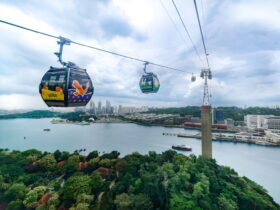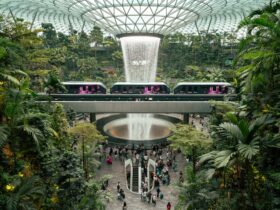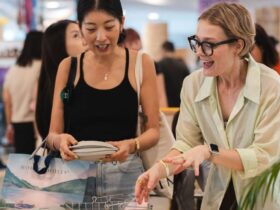Is the era of humanoids and cyborgs upon us?
Photos: Marina Bay Sands
In today’s time and age, it’s nearly impossible to fathom life without the presence of technology.
Considering the growing impact of technology on mankind’s future, ArtScience Musuem’s latest exhibition, Human+, seeks to explore artificial intelligence and the potential of genetic modification.
Our perception of what it means to be human will be challenged in this cutting-edge exhibition, which delves into the our history and the presence of science in our foreseeable future.

The exhibition spans four themed galleries, which are centered on various human interactions with the environment.
They include Chapter 1: Augmented Abilities; Chapter 2: Encountering Others; Chapter 3: Authoring Environments and Chapter 4: Life At The Edges.
Visitors will be greeted by Nadine, a humanoid robot who is capable of engaging in conversations and recognising faces. They can also interact with Neil Harbisson, the world’s first officially recognised humanoid cyborg.
Nadine is not just a whim for scientists to satisfy their creativity — she is is also part of a research programme on assistive technologies, developed for people with special needs in Singapore.
Australian extreme performance artist Stelarc will also be making an appearance at the talk, Conversations: Stelarc with Steve Dixon on 27 May.
He is famously known for surgically inserting a realistic ear into his forearm and has bigger plans for the ear’s future application as a distributed Bluetooth system for communication.
When technology becomes art
Neil Harbisson, a British avant-garde artist and cyborg activitist will also be showcasing himself, literally.
The life-size cybernetic sculptures displayed are an extension of himself, as he has an antenna implanted directly into his head, allowing him to connect to certain data in real time.
Neil, who can perceive colours as sound waves, is also officially recognised by the British government as a cyborg.
He has allowed close friends to send him colors through their smartphones, allowing him to ‘experience’ their feelings in real time.
Other installations to catch include the ‘Area V5’, an entire wall of disembodied robotic eyes that follows nearby movements; a living tissue engineered project called ‘Semi-Loving Worry Dolls’ and a multimedia piece that catalogues the journey of ‘Aimee Mullin’s Cheetah Legs’ — an athlete who races on prosthetic legs.

Confronting moral issues
What are the limits of human life? Is the biotech laboratory the studio of the future?
In Human+, artists like Agatha Haines, Ionat Zurr, Jaemin Paik, and Jimmy Loizeau share their compelling yet controversial work, which will leave you thinking about the extent of enhancing your lives.
Agatha Haines’ Transfigurations, is visually and morally impacting piece of work. Sculptures of babies are showcased, each with surgically implanted modifications designed to solve potential future medical problems.
How far will we go to give our children an edge? Therein lies many questions.
Human+ will run in the ArtScience Museum from 20 May to 15 Oct. There will also be public guided tours on certain days; first-come first-serve with registration at the exhibition entrance.
Tickets available via Marina Bay Sands box offices.
ADVERTISEMENTS











Leave a Reply